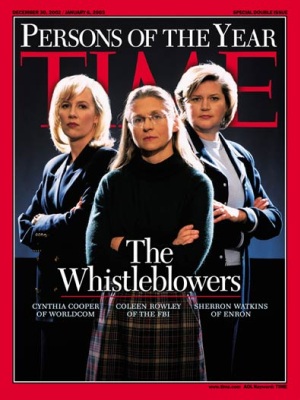Latest News
JPMorgan Chase Settles Whistleblower Suit and Admits to Defrauding Taxpayer Insured Mortgage Programs
JPMorgan Chase’s most recent settlement with the Department of Justice to resolve a p...New York Times Endorses Clemency for Whistleblower Edward Snowden
On New Year’s Day, the editorial board of The New York Times published an editorial t...Whistlelblower Lawsuits Leads to $2.2 Billion Settlement with Johnson & Johnson
The Attorney General’s Office of Florida released the following statement regarding t...Whistleblower Protection

If you have witnessed your employer engaging in fraud, discrimination, or other illegal practices, and you feel morally compelled to speak out against the illegal activity, your act of standing up to your employer and exposing the injustice may be protected whistleblower activity. There are a handful of federal statutes containing whistleblower protection provisions, including the False Claims Act and the Sarbanes-Oxley Act. There are also state whistleblower laws, which vary greatly in terms of the level of protection provided to whistleblowers. These laws are designed to deter employers from retaliating against employees who attempt to stop the harmful or fraudulent activity. If you have been retaliated against for attempting to expose an illegal practice, please be aware that some whistleblower protection laws have statutes of limitations as short as 30 days. Time is of the essence, so contact us immediately for a free consultation.
Whistleblower Claims Overview
The following content is for informational use only obtained from the National Whistleblower Center, a non-profit organization dedicated to advancing and protecting the rights of whistleblowers based in Washington, DC.What laws cover the alleged retaliation?
The first step in reviewing a whistleblower claim is to determine what statutes or common law actions may provide a remedy. A case may be covered under more than one whistleblower protection provision. Depending upon whom one works for and in which state one is employed, the nature and scope of whistleblower protection are varied. In addition to explicit whistleblower protection laws, employees may also be protected under traditional tort or contract for damages resulting from retaliation for whistleblowing.What is protected whistleblower activity?
The underlying purpose of whistleblower protection laws is to allow employees to stop, report, or testify about employer actions that are illegal, unhealthy, or violate specific public policies. However, one of the most hotly contested issues in whistleblower law is the exact definition of protected whistleblower activity. Some states have very narrow definitions while others have definitions that are very broad. An employee or his or her attorney should thoroughly research the state law regarding the definition for his or her state.How long are the statutes of limitations?
One major weakness in many statutory whistleblower protection laws is the short statute of limitations for whistleblower cases. Failure to comply with a statute of limitations is one of the favorite defenses in whistleblower cases. The statute is generallyconsidered to start from the time an employee learns that he or she will be retaliated against- not the last day of employment. Each state has its own statute of limitations for common law wrongful termination actions. Federal statutes protecting whistleblowers also have their own statutes of limitations, some as short as 30 days.
What are the remedies?
The decision on how to pursue the claim will determine what statute of limitations is applicable, the types of damages that are recoverable, and in what forum the claim will be adjudicated. In some states, if the employee is covered by a federal statute, the employee may be preempted from bringing a state action. Some employees have filed for both administrative and common law remedies. Although this approach has been successful, it raises other issues besides preemption, such as res judicata and collateral estoppel. The employee should use extreme care in determining the pros and cons of each potential strategy.What is a basic prima facie case?
The following elements are the basic components of most whistleblower protection claims: (1) that the plaintiff is an employee or person covered under the specific statutory or common law relied upon for action; (2) that the defendant is an employer or person covered under the specific statutory or common law relied upon for the action; (3) that the plaintiff engaged in protected whistleblower activity; (4) that the defendant knew or had knowledge that the plaintiff engaged in such activity; (5) that retaliation against the employee was motivated, at least in part, by the employee’s engaging in protected activity; (6) that plaintiff was discharged or otherwise discriminated against with respect to his or her compensation, terms, conditions or privileges or employment; or suffered some other wrong actionable under state tort or contract theory; (7) thatthe plaintiff can demonstrate, by a preponderance of the evidence, that he or she would not have been subject to an adverse action in the absence of their protected whistleblower conduct.